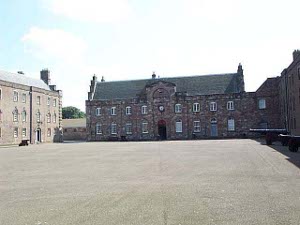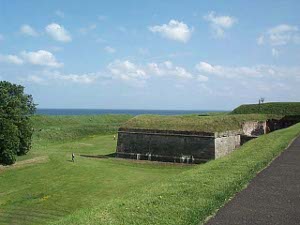Berwick-upon-Tweed proved to be a fascinating destination for a Saturday trip. Most of the passengers got off our train for a shopping day at Newcastle, leaving us to enjoy the increasingly rural scenery as we headed toward the northern border town. Cows and sheep and green fields and stone farmhouses  Barracks, no longer used
looked like picture postcards of English Country Life. The Berwick tourist brochure was full of misty colorful photos of ruined castle walls, knights in armor, and waving grasses, with not much in the way of specific information about what to expect.
Barracks, no longer used
looked like picture postcards of English Country Life. The Berwick tourist brochure was full of misty colorful photos of ruined castle walls, knights in armor, and waving grasses, with not much in the way of specific information about what to expect.
So we were not prepared for the experience of a town which seems to have a lot of Scottish characteristics, with a long tradition of mixing two cultures, where tourists are pleasantly greeted but where daily life is not dependent upon travelers' payments -- in short, a happy place for us to spend the day.
Alighting from the train, we walked along Castle Gate (in many of these fortified towns, the streets are named for the gates in the walls to which they led) past the snooker club and a couple of pubs and a knitting store and a sporting goods store and three or four charity shops (Sue Ryder, British Heart Association, and the Animal Rescue League, among others), past a fish and chips place and a greeting card store, to a small cafe where we had steak and ale pie and a dish called Faggots (meatballs composed of beef liver, bacon and onions, according to the menu). Fortified, we resumed our stroll through the Saturday street market (covers for mobile phones, t-shirts, homemade jams, fruits and vegetables). The proprietor of the excellent used book store thought Dorothy Dunnett invested her sixteenth century characters with modern minds. We thought the books were still terrific stories, and resumed  Berwick Town Museum
our old debate (with each other, not the proprietor) about historical fiction.
Berwick Town Museum
our old debate (with each other, not the proprietor) about historical fiction.
In Berwick the narrow alleys we threaded are called windes (phonetic spelling), which is different from the terms used in York or Truro. We followed the windes, then, past city hall to the 18th century barracks -- the first in England. This was home for centuries to the King's Own Scottish Borderers. They were English troops who wore kilts or plaid trews and marched to the pipers. Disbanded in 1965, their history is recounted in the regimental museum in the barracks, with wondrous tales of risk and heroism now just memories. But the successor to the KOSB is pictured returning from the Gulf War in 1991. Perhaps even better was the exhibit in 10 rooms showing the evolution of the English Army over the years. We saw the changes in weaponry, tactics, strategy, uniforms, discipline and service life. We're glad our service was centuries later with the U.S. Coast Guard Reserve!
Also in the barracks is the Berwick town museum, constructed with imagination and vigor. They have filled two small rooms to the top with objects from the past, from an old-fashioned washing mangle to part of a fishing boat to a pulpit to the door from the poorhouse. There are toys and medical  Berwick's formidable ramparts
equipment and signs and pieces of machinery, with lots of corners and little steps and lookouts and cubbyholes to explore, and signs explaining the significance to the town.
Berwick's formidable ramparts
equipment and signs and pieces of machinery, with lots of corners and little steps and lookouts and cubbyholes to explore, and signs explaining the significance to the town.
We had time to join the sunny spring walkers along the Elizabethan ramparts, quite intact, with bastions giving fields of fire to beat off any attackers. Today the most dangerous creatures were running dogs! Covered with grass and flowers and trees, the wide ramparts formed a lovely high parkland surrounding the town.
We're always finding surprises as we travel. Having neatly pigeonholed Berwick in our minds as a border garrison town of Elizabethan times, we were confronted by the following sign in the railroad station: "This station stands on the site of the great hall of Berwick Castle. Here on the 17th November 1292 the claim of Robert Bruce to the crown of Scotland was declined and the decision in favour of John Balliol was given by King Edward I before the full Parliament of England and a large gathering of the nobility and populace of both England and Scotland."
 Barracks, no longer used
looked like picture postcards of English Country Life. The Berwick tourist brochure was full of misty colorful photos of ruined castle walls, knights in armor, and waving grasses, with not much in the way of specific information about what to expect.
Barracks, no longer used
looked like picture postcards of English Country Life. The Berwick tourist brochure was full of misty colorful photos of ruined castle walls, knights in armor, and waving grasses, with not much in the way of specific information about what to expect.
 Berwick Town Museum
Berwick Town Museum Berwick's formidable ramparts
Berwick's formidable ramparts